 In a post yesterday, we raised the general question of why Royal Caribbean Line (RCL) would run winter cruises which passed off Cape Hatteras, an area known for bad weather, particularly in the winter months? Today many are asking the specific question, why would RCL send the Anthem of the Seas with over 4,000 passengers straight into a major storm which had been predicted days in advance?
In a post yesterday, we raised the general question of why Royal Caribbean Line (RCL) would run winter cruises which passed off Cape Hatteras, an area known for bad weather, particularly in the winter months? Today many are asking the specific question, why would RCL send the Anthem of the Seas with over 4,000 passengers straight into a major storm which had been predicted days in advance?
 We posted this morning about the severe storm encountered by the Royal Caribbean cruise ship, Anthem of the Seas, off Cape Hatteras. As of this morning, the ship was bound for Port Canaveral but was being delayed by weather according to a tweet on the RCLcorp Twitter page. Then shortly after 11 AM, RCL announced that they were turning the ship around and that it will return to Cape Liberty, its terminal in Bayonne, New Jersey, in New York harbor. Thanks to Irwin Bryan for the heads-up.
We posted this morning about the severe storm encountered by the Royal Caribbean cruise ship, Anthem of the Seas, off Cape Hatteras. As of this morning, the ship was bound for Port Canaveral but was being delayed by weather according to a tweet on the RCLcorp Twitter page. Then shortly after 11 AM, RCL announced that they were turning the ship around and that it will return to Cape Liberty, its terminal in Bayonne, New Jersey, in New York harbor. Thanks to Irwin Bryan for the heads-up.
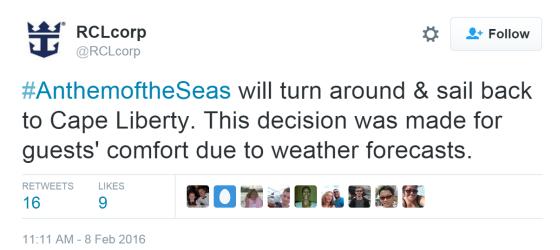
 The winter storm that struck Royal Caribbean’s Anthem of the Seas as it cruised off the coast of the Carolinas this weekend also set off a storm on Twitter. Passengers and crew tweeted photos and video of overturned furniture, damaged rails, and reported large waves and winds of 100-150 MPH. No one was reported to be have been injured.
The winter storm that struck Royal Caribbean’s Anthem of the Seas as it cruised off the coast of the Carolinas this weekend also set off a storm on Twitter. Passengers and crew tweeted photos and video of overturned furniture, damaged rails, and reported large waves and winds of 100-150 MPH. No one was reported to be have been injured.
As reported by the Mirror, the passenger and crew tweets ranged from fearful to humorous. One traveler posted a photo of smashed crockery with the message, “Lord, please help us.”
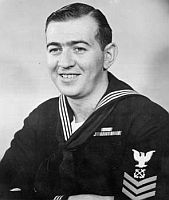 Yesterday, we posted our review of the movie, “The Finest Hours,” a dramatization of the 1952 rescue of 32 of the crew of the T2 tanker SS Pendleton, which had broken in half in a winter Nor’easter in the Atlantic off Massachusetts. The crew was rescued by four Coast Guardsmen in the CG36500, a 36′ wooden motor lifeboat, under the command of Coxswain Bernie Webber. Just to reach the crippled tanker, Webber and his men had to cross the Chatham bar in horrific conditions. They then succeeded in locating the tanker at the height of the storm and rescuing 32 crew in a boat designed to carry 12, including the crew. Their actions are considered by many to be the greatest small boat rescue in history.
Yesterday, we posted our review of the movie, “The Finest Hours,” a dramatization of the 1952 rescue of 32 of the crew of the T2 tanker SS Pendleton, which had broken in half in a winter Nor’easter in the Atlantic off Massachusetts. The crew was rescued by four Coast Guardsmen in the CG36500, a 36′ wooden motor lifeboat, under the command of Coxswain Bernie Webber. Just to reach the crippled tanker, Webber and his men had to cross the Chatham bar in horrific conditions. They then succeeded in locating the tanker at the height of the storm and rescuing 32 crew in a boat designed to carry 12, including the crew. Their actions are considered by many to be the greatest small boat rescue in history.
In 1967, Bernie Webber sat down for an audio interview on radio station WOCB, Yarmouth. He describes the amazing rescue in his own words.
Originally posted on gCaptain. Reposted with permission.
 “The Finest Hours” is far from a perfect movie. Nevertheless, it recounts a remarkable story of heroism at sea that is well worth retelling. For anyone who has spent any time around ships, it is also hard to resist a movie in which one of the lead characters is a grumpy chief engineer.
“The Finest Hours” is far from a perfect movie. Nevertheless, it recounts a remarkable story of heroism at sea that is well worth retelling. For anyone who has spent any time around ships, it is also hard to resist a movie in which one of the lead characters is a grumpy chief engineer.
On February 18, 1952, the T2 tanker SS Pendleton broke in half in a Nor’easter, in 60-foot seas and 70-knot winds off Cape Cod. The US Coast Guard Chatham Lifeboat Station dispatched BM1 Bernie Webber with a crew of three in a wooden 36-foot-long motorized lifeboat to search for the Pendleton. In almost impossible conditions, Webber and his crew crossed Chatham bar, located the ship and rescued 32 of the Pendleton survivors in a boat designed for 12, including the crew. It is considered to be the greatest small boat rescue in history. The movie, “The Finest Hours,” starring Chris Pine, Casey Affleck, and Holliday Grainger is a dramatization of the rescue, based on a book of the same name by Michael J. Tougias and Casey Sherman.
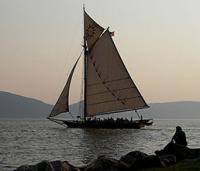 We recently posted that the organization that operates the Hudson River sloop Clearwater was in serious financial trouble and had canceled its yearly music festival. The Poughkeepsie Journal reports that the executive director, Peter Gross, has resigned, citing “significant differences between his and the organization’s vision to the path to building a stronger future for Clearwater and dealing with the organization’s long-standing financial and structural challenges.”
We recently posted that the organization that operates the Hudson River sloop Clearwater was in serious financial trouble and had canceled its yearly music festival. The Poughkeepsie Journal reports that the executive director, Peter Gross, has resigned, citing “significant differences between his and the organization’s vision to the path to building a stronger future for Clearwater and dealing with the organization’s long-standing financial and structural challenges.”
The good news is that donations are up. Anne Osborn, president of the organization’s board of directors, said the Clearwater organization is continuing with a plan to hold fundraising concerts throughout the year. The first concert, held Sunday in Rosendale, raised $12,000. Additionally, $5,000 in donations poured in between the Jan. 20 financial disclosures and the resignation of Gross on Wednesday. That donation figure is now nearly $13,000 and $15,000 in white oak has been donated for the sloop.

A rendering of the proposed redesign of the S.S. United States
In October, the SS United States Conservancy announced that it had retained the services of a broker to explore selling the SS United States for scrap. Prospects for the ship looked dire. In a dramatic reversal of fortune, Crystal Cruises has signed an option to purchase the ship. In the past few years, the Conservancy has been looking for buyers or investors to turn the iconic passenger liner into a hotel, casino or convention center. This is the first proposal that we have seen to return the ship to full operation as a cruise ship.
The purchase is not a “done deal.” The agreement calls for Crystal Cruises to cover the ship expenses of $60,0000 per month for nine months while they perform a feasibility study. Bringing the ship back into service could cost from $700 million to $800 million according to Crystal’s chief executive, Edie Rodriguez. If all goes well, the ship, which had a capacity for 1,928 passengers and 900 crew, would operate as an 800 passenger luxury cruise ship in worldwide service.
 On February 3, 1943, the troopship SS Dorchester was in a convoy bound for Greenland when it was torpedoed and sunk by a German U-boat. Of the 904 soldiers and crew aboard, 672 died. Among the dead were four US Army chaplains who comforted the living and the dying and helped soldiers board lifeboats and rafts. The chaplains gave their life jackets to soldiers without them. As the ship went down, survivors in nearby rafts could see the four chaplains — arms linked and braced against the slanting deck. Their voices could also be heard saying prayers and singing hymns. The four chaplains were Methodist minister Reverend George L. Fox, Reform Rabbi Alexander D. Goode, Roman Catholic priest Reverend John P. Washington, and Reformed Church in America minister Reverend Clark V. Poling.
On February 3, 1943, the troopship SS Dorchester was in a convoy bound for Greenland when it was torpedoed and sunk by a German U-boat. Of the 904 soldiers and crew aboard, 672 died. Among the dead were four US Army chaplains who comforted the living and the dying and helped soldiers board lifeboats and rafts. The chaplains gave their life jackets to soldiers without them. As the ship went down, survivors in nearby rafts could see the four chaplains — arms linked and braced against the slanting deck. Their voices could also be heard saying prayers and singing hymns. The four chaplains were Methodist minister Reverend George L. Fox, Reform Rabbi Alexander D. Goode, Roman Catholic priest Reverend John P. Washington, and Reformed Church in America minister Reverend Clark V. Poling.
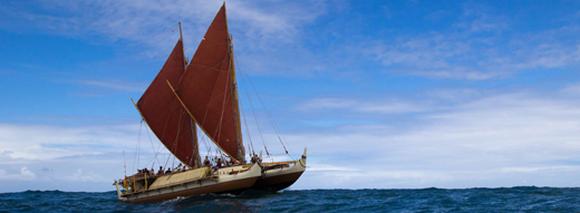 Hōkūleʻa, the Polynesian Voyaging Society double hull sailing canoe has arrived in Brasil, after a voyage across the Atlantic, continuing on its round the world voyage. Over the last 40 years, Hōkūleʻa has sailed over 150,000 across the Pacific. In its current voyage, which began in 2013, Hōkūleʻa called on 24 islands and six countries throughout Polynesia before sailing on to New Zealand, Australia, South Africa and now Brazil. This summer, Hōkūleʻa will visit the US East Coast, before turning east to the Azores, Portugal and Italy. It is expected to return to the Pacific in 2017.
Hōkūleʻa, the Polynesian Voyaging Society double hull sailing canoe has arrived in Brasil, after a voyage across the Atlantic, continuing on its round the world voyage. Over the last 40 years, Hōkūleʻa has sailed over 150,000 across the Pacific. In its current voyage, which began in 2013, Hōkūleʻa called on 24 islands and six countries throughout Polynesia before sailing on to New Zealand, Australia, South Africa and now Brazil. This summer, Hōkūleʻa will visit the US East Coast, before turning east to the Azores, Portugal and Italy. It is expected to return to the Pacific in 2017.
 Hawaii 2 is an island in St. George lake, near the town of Liberty in Maine. It was known as Birch Island until it was renamed by its new owners, who purchased it in October 2014. The new owners are Cards Against Humanity, a quirky Chicago-based party game company, who, in 2014, ran a campaign called “Ten Days or Whatever of Kwanzaa.” They then gave roughly 250,000 people who purchased the holiday game package each an “exclusive” license to 1 square foot of the island.
Hawaii 2 is an island in St. George lake, near the town of Liberty in Maine. It was known as Birch Island until it was renamed by its new owners, who purchased it in October 2014. The new owners are Cards Against Humanity, a quirky Chicago-based party game company, who, in 2014, ran a campaign called “Ten Days or Whatever of Kwanzaa.” They then gave roughly 250,000 people who purchased the holiday game package each an “exclusive” license to 1 square foot of the island.
“You may name your square foot of land. You may use the entire private island for passive, non-commercial, non-motorized recreational activities,” the certificate reads. “You may tell people at parties that you own part of a private island.”
 In the late 60s and early 70s, hovercraft ferries were the ships of the future. Hovercraft, flying on cushions of air, operated across the English Channel carrying passengers and cars at speeds of 40 to 60 knots. Some imagined that one-day hovercraft would cross the Atlantic at 100 miles per hour. That day never arrived. The hovercraft turned out to be too expensive, too inefficient and uncomfortable. The last cross-channel hovercraft ferries stopped operating in 2000, driven from the water by high fuel costs and the slower but more comfortable alternative provided by the Channel Tunnel.
In the late 60s and early 70s, hovercraft ferries were the ships of the future. Hovercraft, flying on cushions of air, operated across the English Channel carrying passengers and cars at speeds of 40 to 60 knots. Some imagined that one-day hovercraft would cross the Atlantic at 100 miles per hour. That day never arrived. The hovercraft turned out to be too expensive, too inefficient and uncomfortable. The last cross-channel hovercraft ferries stopped operating in 2000, driven from the water by high fuel costs and the slower but more comfortable alternative provided by the Channel Tunnel.
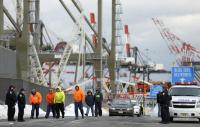 On Friday, more 4,000 longshoremen walked off the job shutting down piers and container terminals in New York and New Jersey. By Saturday, the most longshoreman had returned to work. Strangely, no one seems to know why the wildcat strike took place.
On Friday, more 4,000 longshoremen walked off the job shutting down piers and container terminals in New York and New Jersey. By Saturday, the most longshoreman had returned to work. Strangely, no one seems to know why the wildcat strike took place.
As reported by NJ.com: “We do know it’s an illegal walk-off,” said Phoebe Sorial, general counsel for the Waterfront Commission of New York Harbor. “We did not hear about it beforehand and we don’t know why it’s happening.”
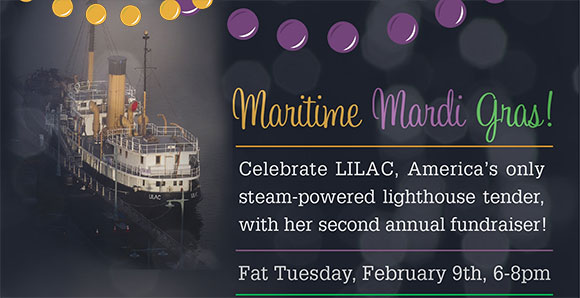 If you are in the New York area come help celebrate Lilac, America’s only steam-powered lighthouse tender at a Maritime Mardi Gras fundraiser on Fat Tuesday, February 9th from 6 – 8 PM on 79 Walker Street on the 6th floor, (one block south of Canal between Layfatte and Broadway), in Manhattan. Let the good times roll with cocktails, light appetizers, and a silent auction.
If you are in the New York area come help celebrate Lilac, America’s only steam-powered lighthouse tender at a Maritime Mardi Gras fundraiser on Fat Tuesday, February 9th from 6 – 8 PM on 79 Walker Street on the 6th floor, (one block south of Canal between Layfatte and Broadway), in Manhattan. Let the good times roll with cocktails, light appetizers, and a silent auction.
Wear your maritime festive best. Mardi gras beads will be provided. Gerry Weinstein will offer tours of his model railroad, steam engines and industrial artifact collection at the end of the evening. The silent auction will include a cruise on the beautiful yacht Ventura, scrimshaw art by Barry Greene, sailing lessons from Sailors NYC, custom maritime tours and more. You must be there to bid! Get your tickets here. Lilac volunteers and former USCG crew and SIU cadets can register for free. If you can’t make it please donate.
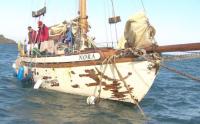 Two American sailors, Bob Weise and Steve Shapiro, both 71, have been attempting to sail across the Atlantic from Norway to Maine in a 40′ gaff rigged sloop named Nora. They began the attempt last July and it has not gone well. In the last seven months, they have been rescued nine times. In this case, persistence is not a virtue.
Two American sailors, Bob Weise and Steve Shapiro, both 71, have been attempting to sail across the Atlantic from Norway to Maine in a 40′ gaff rigged sloop named Nora. They began the attempt last July and it has not gone well. In the last seven months, they have been rescued nine times. In this case, persistence is not a virtue.
Now, even veteran yachtsman is saying enough is enough. In a recent BBC interview, Sir Robin said, “This is no longer a joke. It costs between £6,000 and £8,000 every time a lifeboat is launched. These guys are costing the RNLI a fortune. They need to frankly pack it in or, I hate to say it, get the hell out of our waters.”
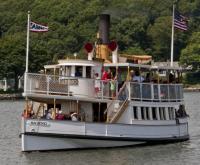 Yesterday, we posted about the boiler problems on the historic steamer Sabino at the Mystic Seaport Museum in Mystic CT. During a major restoration of the steamer, built in 1908, it was determined that the boiler will need to be replaced. The museum’s website notes that “the vessel will operate as a dockside exhibit for the foreseeable future until her boiler is replaced.” A previous captain of the steamer also raised questions as to when or whether the Sabino would be returned to service in an op/ed in The Day, a local Connecticut newspaper. The Museum has now issued a statement about the future of the Sabino, which reads in part:
Yesterday, we posted about the boiler problems on the historic steamer Sabino at the Mystic Seaport Museum in Mystic CT. During a major restoration of the steamer, built in 1908, it was determined that the boiler will need to be replaced. The museum’s website notes that “the vessel will operate as a dockside exhibit for the foreseeable future until her boiler is replaced.” A previous captain of the steamer also raised questions as to when or whether the Sabino would be returned to service in an op/ed in The Day, a local Connecticut newspaper. The Museum has now issued a statement about the future of the Sabino, which reads in part:
“We are disappointed in the decision we needed to make, but we believe it is in the best interest of the vessel to be launched this year and back in the public experience as a dockside exhibit,” said Steve White, president of Mystic Seaport. “That is what is best for her wooden hull and it will give the public access to the vessel while we work to complete the project.”
“We maintain our commitment to returning Sabino to steam operation,” he added.
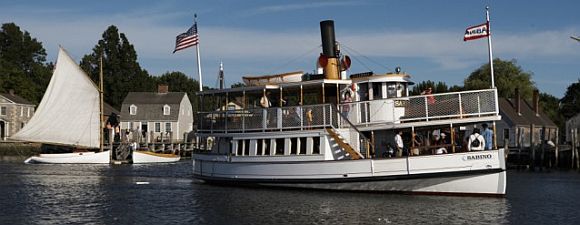 The steamer Sabino, built in 1908, has been a popular attraction at the Mystic Seaport Museum since 1974, offering boat rides on the Mystic River to an estimated 33,000 passengers yearly. The steamboat; which the museum bills as the oldest wooden, coal-fired steamboat in regular operation in the U.S.; will not, however, be in operation this summer and it is unclear as to whether she will be put back in service in the foreseeable future.
The steamer Sabino, built in 1908, has been a popular attraction at the Mystic Seaport Museum since 1974, offering boat rides on the Mystic River to an estimated 33,000 passengers yearly. The steamboat; which the museum bills as the oldest wooden, coal-fired steamboat in regular operation in the U.S.; will not, however, be in operation this summer and it is unclear as to whether she will be put back in service in the foreseeable future.
During a major restoration in the Museum’s Henry B. duPont Preservation Shipyard, it was determined that the boat’s boiler was beyond repair and would need to be replaced. What is happening next is unclear.
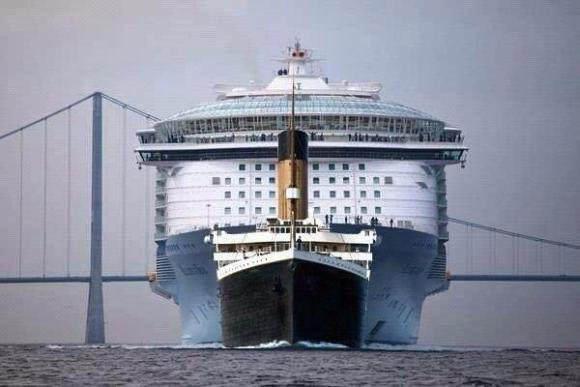 Numbers are fine but sometimes the best way to communicate scale is visually. The image above is what it would have looked like if the largest passenger liner of roughly 100 years ago, RMS Titanic, was followed closely by the largest cruise ship of today, MS Allure of the Seas. Judged by gross tonnage, which is a measure of the volume of the ship rather than the weight, the MS Allure of the Seas at 225,282 GT is almost five times larger than the Titanic, at 46,328 GRT. This comparison is an approximation as the tonnage rules have changed over time. Nevertheless, the image tells the story. Thanks to Dr. Alan Rice for passing the image along.
Numbers are fine but sometimes the best way to communicate scale is visually. The image above is what it would have looked like if the largest passenger liner of roughly 100 years ago, RMS Titanic, was followed closely by the largest cruise ship of today, MS Allure of the Seas. Judged by gross tonnage, which is a measure of the volume of the ship rather than the weight, the MS Allure of the Seas at 225,282 GT is almost five times larger than the Titanic, at 46,328 GRT. This comparison is an approximation as the tonnage rules have changed over time. Nevertheless, the image tells the story. Thanks to Dr. Alan Rice for passing the image along.
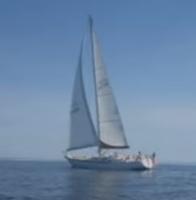 Here on the west bank of the Hudson River, I spent most of the morning digging out from yesterday’s blizzard, which dumped around 30 inches of snow on us. So, it seems like a good time to think of sunshine and warm breezes. The video, after the page break, is of an Albin Nimbus 42, named Sherry Dawn. This summer I hope to be sailing a sister vessel named Arcturus. Right now Arcturus, ex-Obsession, is being worked on by the good folks at Deltaville Yachting Center, in eastern Virginia on the Chesapeake . In the meantime, I will just admire the lovely Sherry Dawn.
Here on the west bank of the Hudson River, I spent most of the morning digging out from yesterday’s blizzard, which dumped around 30 inches of snow on us. So, it seems like a good time to think of sunshine and warm breezes. The video, after the page break, is of an Albin Nimbus 42, named Sherry Dawn. This summer I hope to be sailing a sister vessel named Arcturus. Right now Arcturus, ex-Obsession, is being worked on by the good folks at Deltaville Yachting Center, in eastern Virginia on the Chesapeake . In the meantime, I will just admire the lovely Sherry Dawn.
 Anyone who may doubt that we live on a water planet or that what happens at sea has a huge impact for everyone, even those living far inland, need only look to this year’s El Niño . The US East Coast is being battered by a major blizzard this weekend. Does El Niño, a warming of surface waters in the Pacific, have anything to do with the blizzard, a full continent away? Louis Uccellini director of NOAA’s National Weather says that it could have contributed to the storm. “It really does set the background for this storm to develop and track the way it is tracking.”
Anyone who may doubt that we live on a water planet or that what happens at sea has a huge impact for everyone, even those living far inland, need only look to this year’s El Niño . The US East Coast is being battered by a major blizzard this weekend. Does El Niño, a warming of surface waters in the Pacific, have anything to do with the blizzard, a full continent away? Louis Uccellini director of NOAA’s National Weather says that it could have contributed to the storm. “It really does set the background for this storm to develop and track the way it is tracking.”
The impact of El Niño has not been all bad. After five years of drought on the West Coast, the warmer waters of El Niño have brought much-needed rain to a parched California. Folsom Lake, east of Sacramento, for example, has risen a remarkable 44 feet in just over a month.
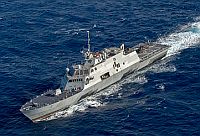 The sad saga of the Littoral Combat Ships (LCS) continues. The USS Fort Worth, the third Freedom Class LCS delivered, was testing its engines at dockside in Singapore and seriously damaged the ship’s combining gear. The LCS have both diesel and gas turbine engines. The combining gear is a complex set of gears which “combines” the output from the ship’s Rolls Royce MT-30 gas turbines and Colt-Pielstick diesel engines to the ship’s water jets. Initial reports say that the casualty was caused by the crew allowing the gear to run dry without adequate lubrication, leading to overheating. Whether the casualty was indeed due to operator error or a class-wide problem remains to be seen.
The sad saga of the Littoral Combat Ships (LCS) continues. The USS Fort Worth, the third Freedom Class LCS delivered, was testing its engines at dockside in Singapore and seriously damaged the ship’s combining gear. The LCS have both diesel and gas turbine engines. The combining gear is a complex set of gears which “combines” the output from the ship’s Rolls Royce MT-30 gas turbines and Colt-Pielstick diesel engines to the ship’s water jets. Initial reports say that the casualty was caused by the crew allowing the gear to run dry without adequate lubrication, leading to overheating. Whether the casualty was indeed due to operator error or a class-wide problem remains to be seen.
